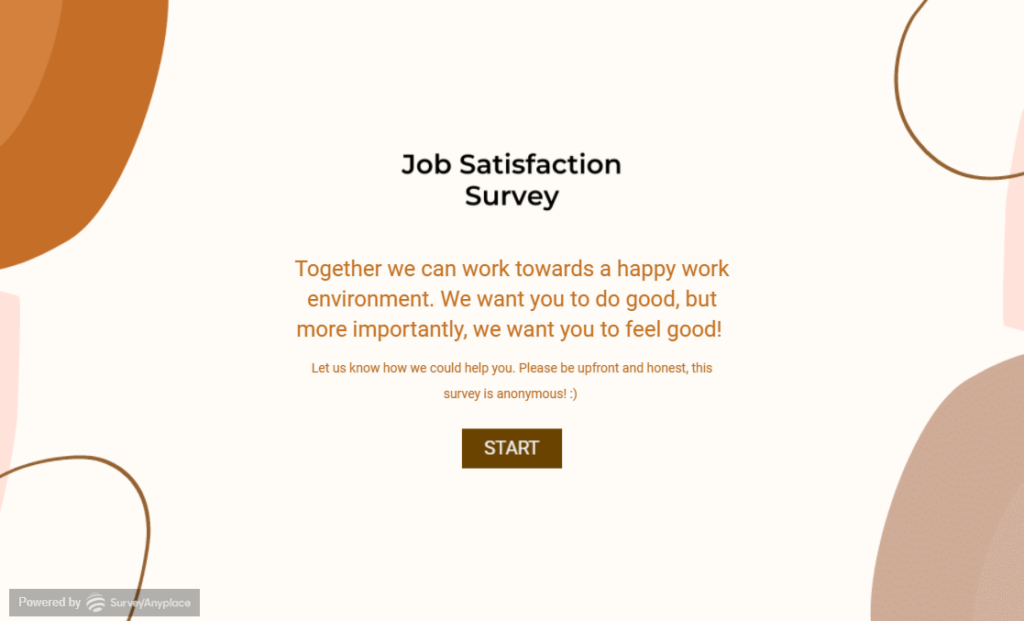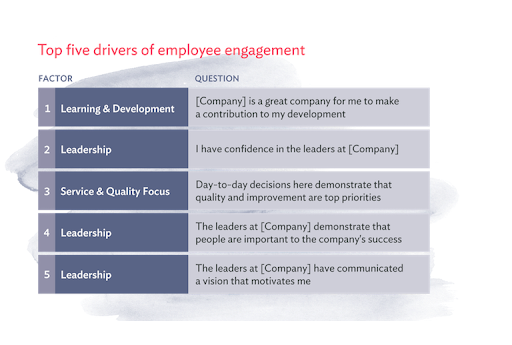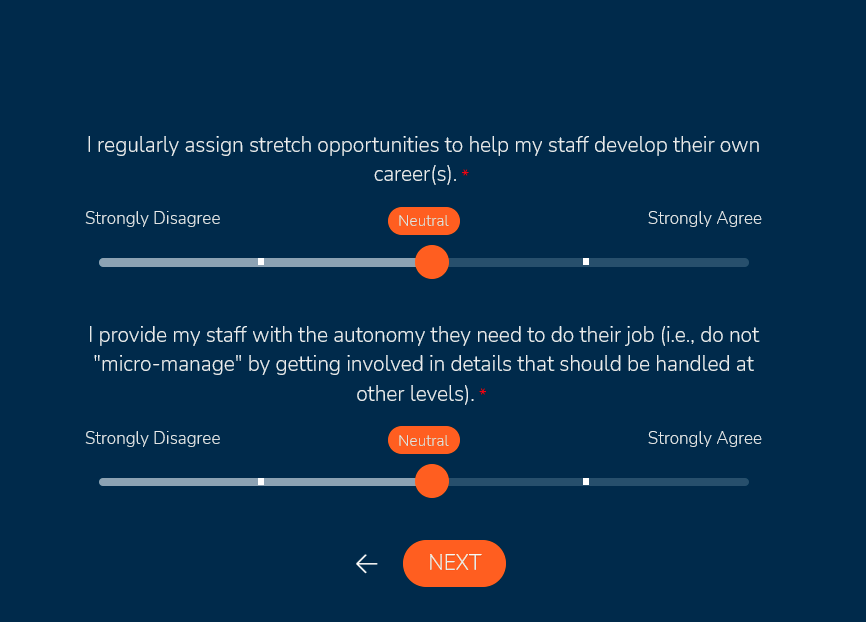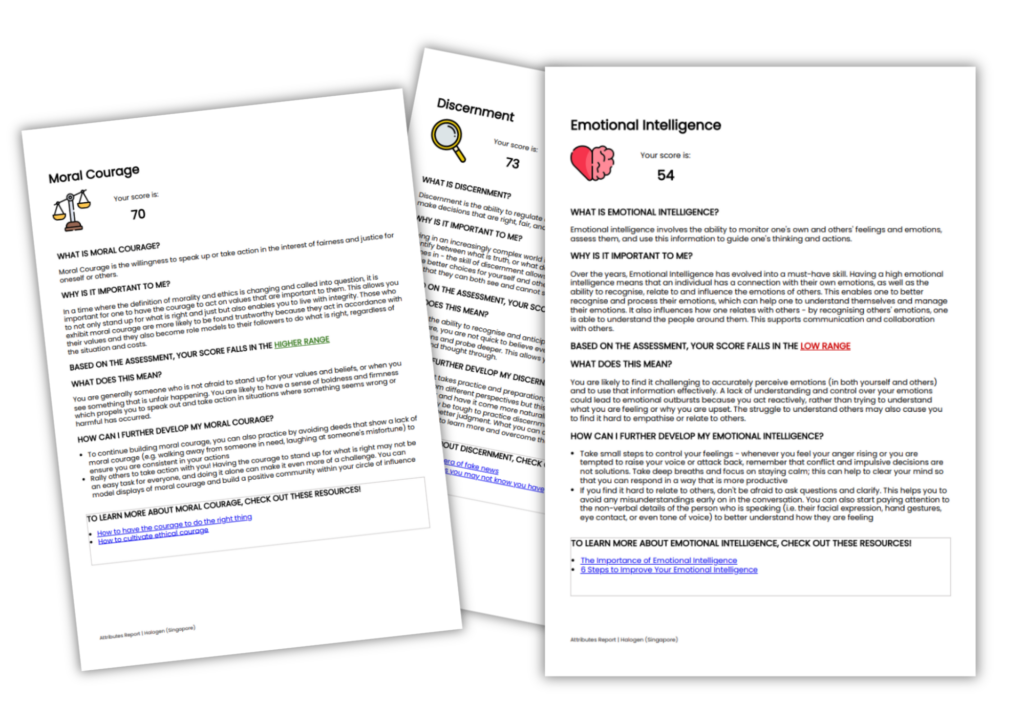The concept of employee engagement has been an elusive one for organizations to grasp. Not because it is confusing, but simply because it’s tough to measure.
That’s where an employee engagement survey comes in.
Measuring employee engagement provides you with a wealth of information that is not easily obtainable elsewhere and can be used to comprehend your team’s performance and improve overall results.
Unlike performance reviews, employee engagement surveys provide companies with a way to actually “hear” what their employees have to say.
Considering that companies with high employee engagement are 21% more profitable, these surveys become valuable tools that companies should use across all industries. However, one assessment is not enough to fully understand employee engagement.
This comprehensive guide will cover a wide range of topics around employee engagement surveys, such as:
- The different types of employee engagement assessments.
- Why companies should include competency assessments.
- How management employee surveys can lead to positive change within a company.
- How to attract and retain the top talent by fully understanding the company culture.
- The various tools that are available for surveying employee engagement.
Each of these sections will delve deep into the topic to truly define the concept of employee engagement, understand the usefulness of all the different employee engagement surveys, and discover how your company and employees can benefit when the available tools are used correctly.
What are the different types of employee engagement surveys?
First, we will outline four different types of employee engagement assessments. Although the most common revolve around employee satisfaction, there are four surveys in total that measure employee engagement:
- Employee satisfaction surveys
- Competency assessments
- 360° Leadership surveys
- Company culture surveys
However, to discuss the different types of employee engagement surveys, the term ’employee engagement’ needs to be defined.
Employee engagement is the extent to which employees feel passion for their jobs and the work they do. Engagement indicates that a committed employee is more likely to put discretionary effort into their work.
Employee engagement goes beyond employee satisfaction and serves to drive work performance. In other words, how much an employee cares about their work and the company that they work for.
When an employee is engaged, they are also much more likely to put in extra effort which leads to:
- Better business outcomes
- Higher service
- Higher customer satisfaction
- Increased sales
- Increased profit levels
- Higher shareholder returns
With these kinds of results attributed to employee engagement, it’s no wonder that most companies seek to understand and quantify it.
This information can be tough to grasp if you don’t use the right tools to measure it and convert it into quantifiable data.
For decades, companies have focused on employee satisfaction, but the problem is that happy employees are not necessarily engaged employees.
Employee engagement is a much better indicator of success for organizations as employees who feel heard are empowered to perform better. That is why companies need to switch their focus from satisfaction to engagement.
Measuring engagement is the first step. Companies who communicate the results with their employees and act on what was discovered in the data truly benefit from using employee engagement assessments.
Employee satisfaction surveys
Employee satisfaction surveys are the most common type of employee engagement assessments available. These tend to be used by most organizations annually to understand the level of satisfaction among employees better.
Employee satisfaction surveys allow your HR team to measure, analyze and gain insight into the overall health of your company based on the happiness of your workforce.
The results will allow them to improve employee satisfaction in any number of ways. For example, they could begin employing the right employee recognition program, prioritizing virtual recognition, or career development opportunities, and acknowledging employee milestones.
There are numerous employee satisfaction surveys, but to truly determine employee engagement in this area, it may be helpful to create a custom job satisfaction survey based on your companies specific needs.
The benefits of using custom job satisfaction surveys are that they are tailored directly to your employees. This means that your HR department will generate the exact information that they need.

Company culture surveys
Company culture or work culture surveys are valuable tools to collect insights from employees about their views on the culture found within the workplace. Culture assessments can help to define the company values that your employees find essential.
By discovering what your employees value the most about the company, you define the company culture and then use this information to attract and retain high-quality employees.
For example, a Business Needs Assessment can measure leadership positions’ goals and values. Next, Job Satisfaction Surveys determine which of these values employees support or reject.
The benefit of conducting these types of surveys is that you become better aware of your own company culture. As a result, it can be one of the main tools used to nurture and improve employee engagement.
What is company culture?
Attract and retain top talent by understanding company culture
What can you learn from a company culture assessment?
- Leadership
- Enablement
- Alignment
- Development
- Would your employees recommend your company to a friend when a job opening comes available?
- Do your employees find your company diverse enough and inclusive of everyone regardless of race, class, and creed?
- Do they feel respected by your company (i.e. are their opinions heard/is their work recognized/do they feel valued)?
- Do they feel your company promotes teamwork and collaboration over competition?
- Do they feel they have the opportunity to grow and progress within your company?
- Do they have all the necessary tools they need to perform their job efficiently?
Company culture assessment example questions
For the best results, you should create your culture assessment and break up questions according to the four categories discussed previously.
L – Below are some examples of leadership questions:
- Do the leaders at my company keep people informed about what is happening?
Determining the level of communication employees receive from their superiors is important as it directly affects engagement. - Is my manager a great role model for employees?
This question allows employees to think about their manager within the broader context of the company instead of simply through the basis of their direct relationship. - Have the leaders at my company communicated a vision that motivates me?
A connection to something bigger than themselves can help to inspire and motivate employees, so they need to feel informed about what’s happening in the company.
E – Below are some examples of enablement questions:
- Do I have access to the things I need to do my job well?
This question helps to ensure that you are providing employees with the right tools, resources, and facilities needed to do their job well and that nothing is lacking. - Do I have access to the learning and development I need to do my job well?
Learning and development is a big factor in employee engagement and this question informs you about whether they feel supported to improve their skills. - Do most of the systems and processes here support us in getting our work done effectively?
This question focuses on the company’s infrastructure and whether it is sufficient enough to ensure that employees can do the work expected of them.
A – Below are some examples of alignment questions:
- Do I know what I need to do to be successful in my role?
If an employee knows what they are expected to do to be personally successful, they are more likely to be in alignment with the company. - Do I receive appropriate recognition when I do good work?
When an employee gets recognition for their work and success, they stay motivated, feel inspired and become more engaged in the organization. - Do day-to-day decisions demonstrate that quality and improvement are top priorities?
Most employees value doing work that they can be proud of, so the company needs to align with this by demonstrating the same commitment to quality work.
D – Below are some examples of development questions:
- Has my manager (or someone in management) shown a genuine interest in my career aspirations?
By taking interest in employees’ career aspirations, managers indicate that there are growth and progress opportunities available at the company. - Do I believe there are good career opportunities for me at this company?
Creating opportunities for your employees to progress within the company is an essential part of retaining top-quality employees. - Is this a great company for me to make a contribution to my development?
Development drives engagement which means that employees value companies that make a contribution to their development within their given industry.

Company culture assessments can play a big role in helping companies define their culture and create a pleasant work environment that attracts new employees while retaining current employees.
360° leadership surveys
Another important employee engagement assessment is the 360° leadership survey. 360° feedback is a process through which feedback from an employee’s subordinates, colleagues, and supervisor, as well as a self-evaluation by the employee themselves, is gathered. It provides a comprehensive view of leadership. Leadership surveys offer employees a way to assess the leadership or management in an organization. This is important because the leadership of a business directly influences the abilities of employees to oversee the growth and progress of that particular organization.
When it comes to leadership a multi-level evaluation tool is most effective. In other words, a leader would receive feedback from those above, below, and besides them within the company hierarchy.
This type of 360° feedback, provides HR with a clear understanding of how a leader in the company is perceived.
Since management can be one of the main reasons why employees leave a company, it’s important to regularly assess those in leadership roles whether it be monthly, quarterly, or yearly. By understanding where there is a gap in communication and acting on it, high employee turnover can be prevented and overall company engagement can be improved.
In this section, we’ll uncover how surveying your employees about management and leadership can lead to positive changes and increased employee engagement.
Why is it difficult for employees to speak about management?
The short answer to this is self-preservation.
Employees are afraid that speaking about management in an honest manner will cost them their jobs.
According to this piece in the Harvard Business Review, most employees find it tough to speak up in general, not just when it comes to management. This means that it is very unlikely for employees to give honest feedback about management directly.
Some of the reasons for this are:
- They don’t believe leadership wants to hear their thoughts, opinions, or ideas on matters relating to management.
- They don’t get asked to provide feedback.
- They lack the confidence to share the truth because of the fear of repercussions.
- They don’t have the skills to share their thoughts and feelings effectively.
- They don’t think anything will change and feel it’s not worth the effort.
Benefits of 360° leadership surveys
360° feedback type leadership surveys have several benefits.
First and foremost is the ability to uncover any problems within your company. Once you identify any underlying issues related to management or leadership, you can address them. This, in turn, leads to positive change within the organization and improves employee engagement across all levels.
For example, an employee may approach their manager with a concern. But if that manager doesn’t know how to listen and then follow-up or actually find a solution to the employee’s concern, that employee will end up feeling unheard, dissatisfied, or under-valued.
Now, this may not be the manager’s intention. In many cases, those in management or leadership positions simply don’t have the skills to create an environment that promotes open communication.
However, if this employee can share this experience as part of a 360° feedback leadership survey, this gap in the manager’s skills will be identified and can be addressed through continued training or skills development so that it doesn’t occur again in the future.
In this way, employees feel heard, like their opinions matter, and that their feedback actually leads to positive change. Similarly, those in leadership roles are empowered and given ways to improve their management abilities. This bolsters the overall employee engagement and results in a happy workforce.
Questions you should include in your 360° leadership surveys
Once again, there are plenty of different questions you could ask in a 360° feedback survey depending on your business model and structure.
As with competency assessments, you’ll want to customize these survey questions to suit your unique requirements. The survey questions could change according to department, management level, or even based on who will be providing the feedback.
The options to tailor your 360° feedback surveys are endless.
A 360° feedback assessment doesn’t just include feedback from a group of peers within the company but also consists of a self-assessment. This ensures that leaders think about their current strategy and can assess where they should be putting their focus. As a result, they have a better understanding of the feedback they receive since they have taken some time to assess themselves as well.
Below are some examples of questions to include within the self-assessment section of a 360° leadership survey:
- I regularly assign stretch opportunities to help my staff develop their own career(s)?
- I provide my staff with the autonomy they need to do their job (i.e., do not “micro-manage” by getting involved in details that should be handled at other levels)?
- I have clear goals for my team?
- I give actionable feedback to my team on a regular basis?
- I have had a meaningful discussion with all my staff about their career development in the past six months?
- My actions as a manager show that I value the perspectives of my team, even if they are different from my own?
- I keep my team focused on priorities, even when it’s difficult (i.e., declining other projects)?
- I make tough decisions effectively (i.e., decisions involving multiple teams)?
- In meetings, I make sure everyone has a voice?
- I welcome others to correct my way of thinking?

Tools to create and manage a 360° leadership assessment
A lot of data is collected from different sources during a 360° feedback survey which means you need to use technology to create and manage each survey and the subsequent responses.
The Pointerpro 360 Assessment Tool provides companies with the perfect solution. Your organization can easily use this tool to allow a group of coworkers to evaluate a peer’s performance.
Ideally, you want to use technology that streamlines this complex process and makes it easy to compile and analyze data by:
- Integrating easily with your favorite tools and software via Zapier.
- Offering engaging email options for inviting and communicating with respondents.
- Providing a variety of quality question types, features, and templates.
- Allowing for real-time reporting that can easily be generated, exported, and shared.
All these aspects serve to make the experience simpler for those conducting the surveys, the respondents, and the people who analyze and share the data.
Since management has such a strong effect on employee retention, it stands to reason that 360° feedback leadership surveys should be used by all companies. But it isn’t the only factor in employee engagement.
The following section will focus on performance tracking and how it can help employees reach their full potential, which helps a company to retain top talent.
Competency assessments
A competency assessment focuses on employee performance in comparison to the required benchmarks such as skill, knowledge, and attributes.
When the employee performs at a level that’s above this standard it’s viewed as a strength and if they perform at a level below that standard it’s viewed as a weakness. This makes it easy for the company to determine existing competencies and gaps in knowledge or skills.
Armed with this information, an organization can help its employees reach their full potential which leads to increased employee engagement.
Why your company should include competency assessments & templates
Competency assessments can help your organization identify the various strengths and weaknesses of your employees. Once understood, these strengths and weaknesses can be addressed in a practical manner such as additional training to benefit both your employees and your business.
By offering learning and skills development to those who need it, you effectively increase your employee engagement as they feel heard, seen, and respected. Your employees will get better at their job and grow within your company.
Additionally, this feedback and training can start right away when a competency assessment tool is used that provides two-way feedback in the actual report. Not only do you get valuable information about your employee, but your employee can also view their results with a personalized report highlighting competencies and potential gaps in skills and how to tackle these by providing actionable tips.
Throughout this section, you’ll learn how your company can use competency assessments to:
- Map out career paths
- Spot strengths and weaknesses
- Provide meaningful coaching according to the results
- Know when to offer continued learning and skills development
What are the benefits of conducting a competency assessment at your company?
There are numerous benefits to conducting competency assessments in your company. The main benefit, of course, is employee engagement, but this section will discuss a few other benefits too.
Although this type of assessment is usually used for existing employees, it can also be a valuable asset in the recruitment process.
For example, David Endean founded his company Passions and Talents using a competency assessment on Pointerpro that measures the strengths and weaknesses of an individual with the aim of helping them to find a job that they love. Employers can similarly use these assessments to determine what position potential recruits are best suited to as a way of ensuring their success within the company.
It’s a win-win situation for both parties.
Here are some more benefits to conducting a competency assessment:
- Identify employee strengths so that their skills and abilities can be recognized and rewarded through promotions or position changes which will make the employee feel more invested (or engaged) in the company.
- Identify employee weaknesses so that support can be provided for continued learning or training and relevant skills development which will help the employee to grow, improve and feel more committed to their role within the company.
- Map out potential career paths within the company according to these strengths and weaknesses to help employees grow and progress over time so that they feel like they have a future with the company.
- Use the assessment results to pair employees with the appropriate mentors so that your organization provides meaningful mentorships that are actually beneficial to employees.
Get insight into where your company can provide continued learning and skills development for both new and existing employees across all departments to keep your staff happy and engaged within the company.

What questions should you include in your competency assessment?
- A logical reasoning test
- A numerical reasoning test
- A personality test
- Time management – are you able to prioritize and meet deadlines?
- Stress management – are you able to work under pressure and maintain self-control?
- Passion for excellence – are you willing to go the extra mile?
- Self-awareness – do understand your strengths and weaknesses?
- Presentation skills – are you able to convey ideas in a group setting?
- Teamwork – can you collaborate with others to accomplish your collective goals?
- Written communication – can you write clearly and concisely enough to convey your ideas?
- Influencing skills – are you able to work well with others, gain support and obtain information?
- Customer service – can you understand customers and meet their needs?
- Conceptual thinking – are you able to make sense of complex information and respond to challenges?
- Creative and innovative thinking – are you able to draw inspiration from external factors to come up with new ideas and concepts?
- Analytical thinking – are you able to use logical thought and reasoning to break down undefined problems?
- Decision making – are you able to make effective decisions in a way that solves problems?
- Strategic thinking – can you look into the future to develop long-term goals and strategies?
- Goal setting – are you able to set and meet goals and expectations?
- Industry knowledge – do you have knowledge of the trends, history, and future of your industry?
- Organizational awareness – do you understand the different aspects and departments of the organization as a whole?

Understanding the benefits of using competency assessments in your business to foster employee engagement can really help to propel your company forward. But it’s just as important to allow your employees to assess their superiors to ensure that management and leadership are kept in check.
Employee engagement survey tools
This final chapter will review how a survey tool such as Pointerpro can easily be used to help management and HR professionals alike create and analyze the surveys that have been discussed throughout this guide.
Knowing the value of using employee engagement assessments doesn’t help unless you know how to create, implement, and analyze the surveys. There are plenty of different tools that make assessing employee engagement easier.
So, it’s essential that you select a survey tool with the right features for your business.
How to choose the right type of survey?
When choosing an employee engagement assessment tool for your company, make sure it has the following features:
- The templates, forms, results, question types, and styles all need to be easily customizable according to the requirements of your company and the goal of the assessment.
- The entire process from start to finish should be automated to allow your company to grow and scale without unnecessary extra time being spent on administering assessments.
- Your survey tool should be able to provide an automatic feedback report that both the administrator and respondent receive once the assessment is complete. This form of two-way feedback ensures that respondents feel like they get something back for their time spent sharing information. This is a unique and special feature that makes Pointerpro stand out from the competition.
- When it comes to surveys and assessments the question format matters so it’s important that your survey tool can offer different question types such as text choice questions, open-ended questions as well as multiple-choice questions.
- The survey and reports should be fully branded to your company which means you need a survey tool that offers white-label options so that you can add your own brand identity to all parts of the assessment and report.
- A survey tool should have effective technological features that deal with the many complexities of reading, generating, and sharing data on the back-end while still making it an easy-to-use tool for customers.
Conclusion
This guide has comprehensively explained the many aspects involved in employee engagement surveys. There are four different types of employee engagement surveys that are used by organizations to measure employee engagement:
- Employee satisfaction surveys
- 360° leadership surveys
- Company culture assessments
- Competency assessments
Utilizing these four different types of surveys can save your organization time and money, leaving you with satisfied employees that will grow with your company over the years.
While it’s vital to have these surveys in place, using the proper technology to create these surveys is also important.
Create your own employee engagement surveys that have been tailored to your business and requirements. Once created you can automate the administration of these surveys and benefit from automatic feedback reports that get sent to both you and your employees for instant results.
By using a comprehensive survey tool such as Pointerpro you can make employee engagement a top priority within your business.






